ClusterTrap experiment
ClusterTrap has been designed to investigate
properties of atomic clusters in the gas phase with particular emphasis on the
dependence on the cluster size and charge state. The combination of cluster source,
ion traps and time-of-flight mass spectrometry allows a variety of experimental
schemes including collision-induced dissociation, photo-dissociation, further
ionization by electron impact, and electron attachment.
Experimental setup
Positively or negatively singly-charged clusters are produced in a laser-ablation
source (1) and accumulated in a radiofrequency ion trap (2a). Then, the cluster ion bunch
is transferred
via a quadrupole
ion deflector into a Penning ion trap (3) and there prepared and subjected
to one or several reaction steps (4). Subsequently, the product ions
are analyzed by time-of-flight
(ToF) mass spectrometry (5). Alternatively, the cluster ion bunch is
transferred into a second radiofrequency ion trap (2b) for electron interaction
studies. Again, product analysis is realized via storage in the Penning trap
and ToF mass
spectrometry.
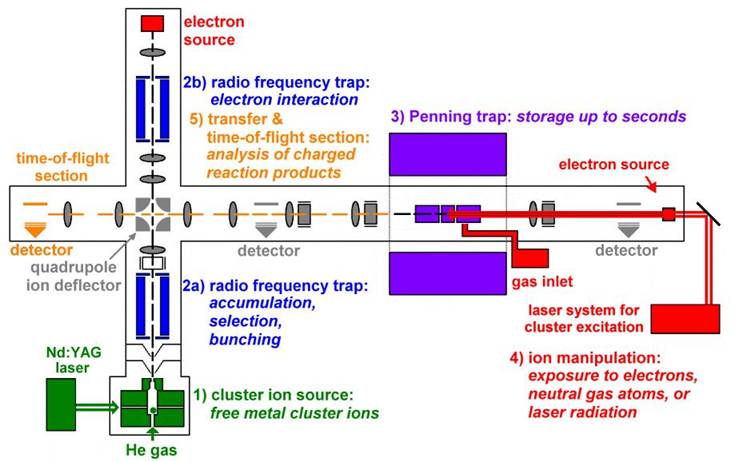
Experimental cycles
The setup is operated with two or more different
cycles, which are alternately (and therefore quasi-simultaneously) executed. In
the “measurement cycle”
the experiment
parameter of interest is varied, while it remains at a constant
value in the “reference cycle”.
Thus, changes in the ion signal over time (due to causes different from the
parameter varied for the particular experiments) are monitored and compensated
in the data evaluation. Typical cases for such applications are drifts of the cluster ion
source accompanied by changes in the cluster production.
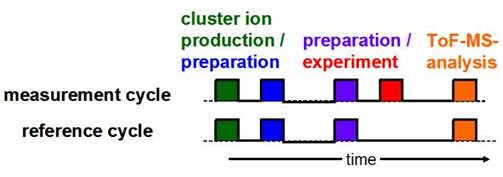
Cluster ion source and cluster-preparation trap
The clusters are produced by laser vaporization of a
metal wire in a helium gas pulse. The laser pulse (532nm, 10mJ, 5ns) and the
helium gas pulse enter the cluster source through the same port. Material of
the metal wire (element M) is vaporized and cooled in the gas pulse, causing
formation of metal clusters Mnz,
consisting of n atoms (cluster size),
which are neutral or having the charge state z. Driven by expansion of the gas pulse through a nozzle into
vacuum, the clusters leave the source through two skimmers, which a part of
differential pumping stages. An electrical dc-field between the nozzle and the
first skimmer additionally accelerates cluster ions of respective charge sign
(i.e. either cations or anions).
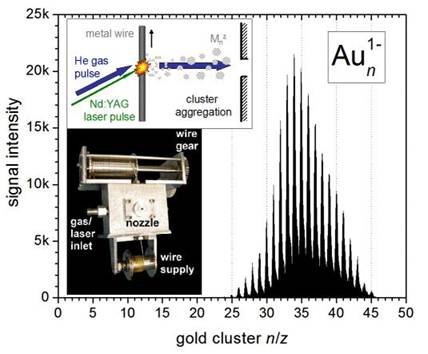
After leaving the source, the cluster ions are
captured in a linear radio-frequency quadrupole (RFQ) trap. A
radio-frequency electric field applied between pairs of
RF-electrode rods
provides radial ion confinement (x-y plane). Potentials applied to endcap electrodes
confines the ions in axial direction, i.e. in direction parallel to the
RF-electrodes. By consecutive capture events, cluster ions are accumulated in the RFQ. Application of a dc-potential to
axially mounted “plate
electrodes”, whose distance to the trap axis varies along the
axial dimension, causes an axial compression of the trapped cluster
ensemble. Additionally, selection of
single cluster species by removal of the unwanted ions might be realized by
application of RF-excitation fields (e.g. SWIFT-excitation). For easy variation
of the trapping parameters, the RFQ is operated as a “Digital Ion Trap” (DIT), i.e. rectangular RF-voltages
are used, rather than sinusoidal ones.
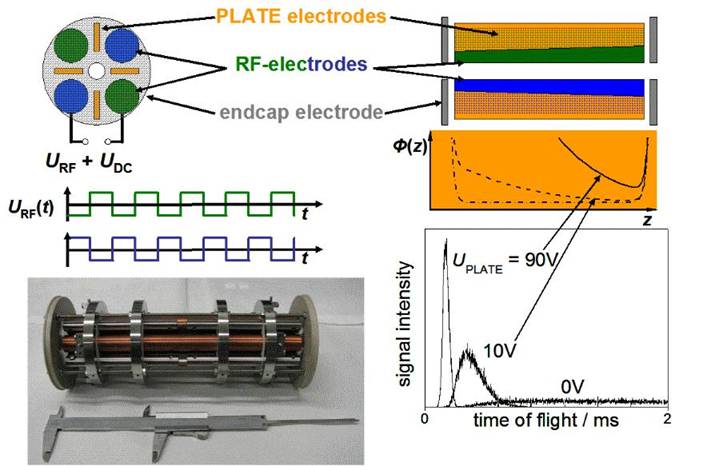
Penning trap
Cluster ions are stored in a Penning ion trap for up
to several seconds. A superconductiong magnet provides a magnetic field (B = 12 T),
which confines the ions in the plane perpendicular to the magnetic field lines.
A voltage potential applied to cylindrical endcap, correction and ring electrodes of the trap
provides an harmonic trapping potential U(z)
for axial ion confinement. The ring electrode is azimuthally split into 8
segments to allow for application of radial
excitation fields (e.g. dipolar, quadrupolar and octupolar). Different
excitation schemes provide motional excitation of trapped ions, used for e.g.
- increase of ion oscillation radii for collision
experiments with neutral background gas,
- increase of ion oscillation radii for selective
removal of cluster species from the trap,
- conversion of ion oscillation modes (cyclotron &
magnetron) for buffer-gas assisted centering of ions.
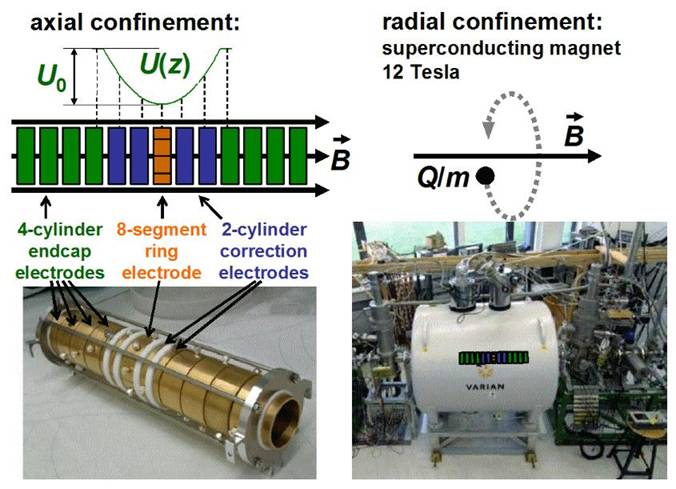
In a complementary fashion to radial excitation, also axial excitations fields can be
applied, e.g. used for axial excitation of trapped electrons. Furthermore, the
split ring electrode allows for a non-destructive ion detection method, the Fourier Transform Ion Cyclotron Resonance
(FTICR), where radial ion motion is
detected by means ions' image currents in the ring segments after a broadband excitation.
A Fourier analysis of the obtained time signal resolves the ion cyclotron
frequencies, which depend on the mass-over-charge-ratio of the trapped ion
species. FTICR-detection allows for very high mass accuracy and mass
resolution. Another non-destructive method is the electronic ion detection, where the axial ion motion is monitored.
By variation of the trapping potential U0
the axial motional frequencies of the trapped ions are successively brought
into resonance with a LC circuit,
causing an energy transfer into the trap which is detected. However, as both
detection methods require a certain ion density in the trap, they are less
suitable for the present cluster experiments, where only little ion numbers are
involved.
Time-of-flight mass spectrometer and potential lift
For sensitive detection of reaction products, these
are axially ejected from the Penning trap into the drift section of a Time-of-Flight
(ToF) mass spectrometer and recorded on a single-ion-counting
detector (MCP with conversion electrode). To obtain high kinetic energies, the
ejected ions enter a drift tube, which is operated as a potential lift. The ions are strongly accelerated into the
potential lift by a strong potential gradient, caused by a high potential at
the tube. While the ions pass the tube, its potential is lowered again to match
the potential of the remaining drift section. The ions leave the potential lift
and continue to the detector at a high kinetic energy, without having the
complete drift section to be floated at correspondingly high potentials. This
is advantageous, as part of the drift section is also used for ion transfer
into the Penning trap at much lower ion kinetic energies. However, the
potential lift allows only the detection of a limited range of ion masses,
because the length of the potential-lift tube relates to the time, the ions
need to pass the tube. The lift potential must be varied after the heaviest
(i.e. slowest) ions have entered the tube, but also before the lightest (i.e.
fastest) ions pass the end of the tube.
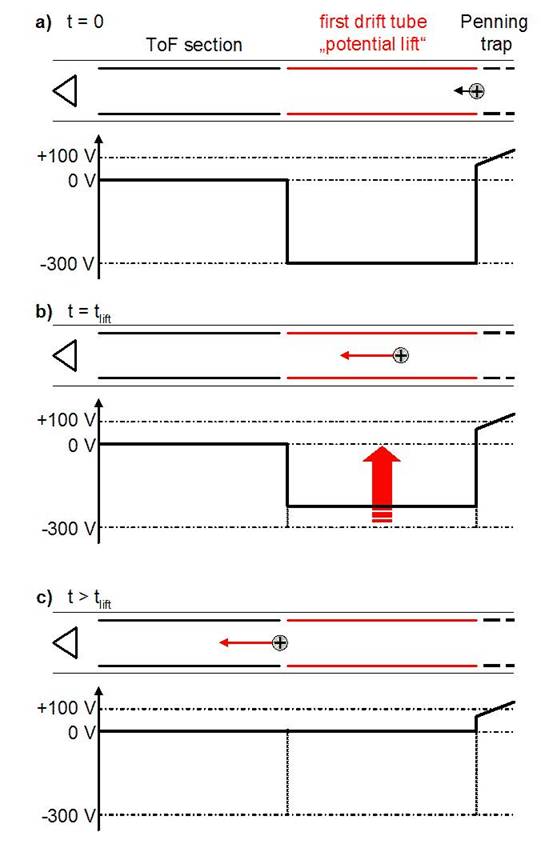
Reviews of the ClusterTrap experiment:
- The new
ClusterTrap setup
F. Martinez, G. Marx, L. Schweikhard, K. Hansen, A. Vass, F. Ziegler
Eur. Phys. J. D 63, 255-262 (2011) - Trap-based
cluster research and cluster-based investigations of ion storage at
ClusterTrap
L. Schweikhard, M. Breitenfeldt, A. Herlert, F. Martinez, G. Marx, N. Walsh
AIP Conf. Proc. 862, 264-273 (2006) - Laser
Investigations of Stored Metal Cluster Ions
L. Schweikhard, K. Hansen, A. Herlert, M.D. Herráiz Lablanca, G. Marx, M. Vogel
Hyperfine Interact. 146/147, 275-281 (2003) - New
approaches to stored cluster ions
L. Schweikhard, K. Hansen, A. Herlert, G. Marx, M. Vogel
Eur. Phys. J. D 24, 137-143 (2003) - Recent gold
cluster studies in a Penning trap
L. Schweikhard, K. Hansen, A. Herlert, M.D. Herráiz Lablanca, G. Marx, M. Vogel
Int. J. Mass Spectrom. 219, 363-371 (2002) - Metal
clusters as investigated in a Penning trap
L. Schweikhard, A. Herlert, M. Vogel
in "The Physics and Chemistry of Clusters" (Proceedings of the Nobel Symposium 117),
E.E.B. Campbell and M. Larsson (eds.),
World Scientific, Singapore, 2001, ISBN 981-02-4529-7; pp. 267-277. - The Mainz Cluster Trap
L. Schweikhard, S. Krückeberg, K. Lützenkirchen, C. Walther
Eur. Phys. J. D 9, 15-20 (1999) - Trapped Metal Cluster Ions
L. Schweikhard, St. Becker, K. Dasgupta, G. Dietrich, H.-J. Kluge, D. Kreisle, S. Krückeberg, S. Kuznetsov, M. Lindinger, K. Lützenkirchen, B. Obst, C. Walther, H. Weidele, J. Ziegler
Physica Scripta T59, 236-243 (1995) - A Penning trap mass
spectrometer for the study of cluster ions
St. Becker, K. Dasgupta, G. Dietrich, H.-J. Kluge, S. Kuznetsov, M. Lindinger, K. Lützenkirchen, L. Schweikhard, J. Ziegler
Rev. Sci. Instrum. 66, 4902-4910 (1995) - A
Penning Trap for Studying Cluster Ions
H.-J. Kluge, H. Schnatz, L. Schweilhard
Z. Phys. D 3, 189-194 (1986) and Lecture Notes in Physics 269, 32 (1987)